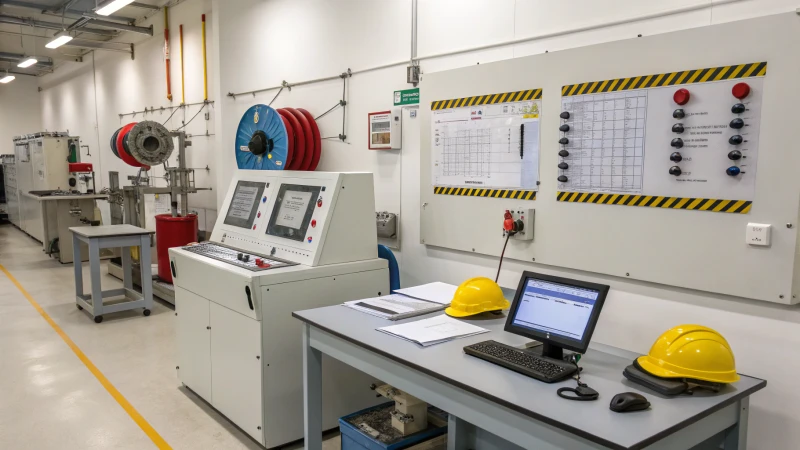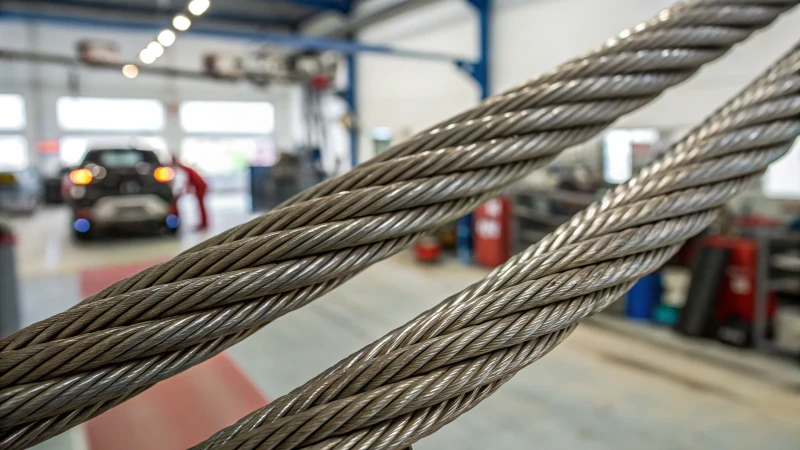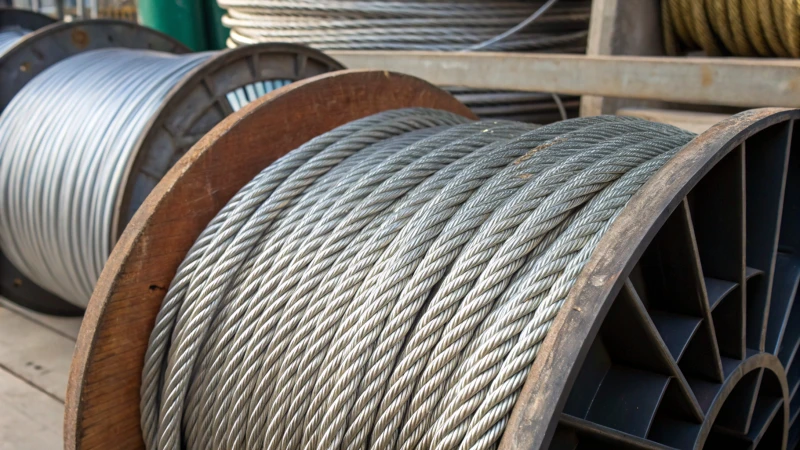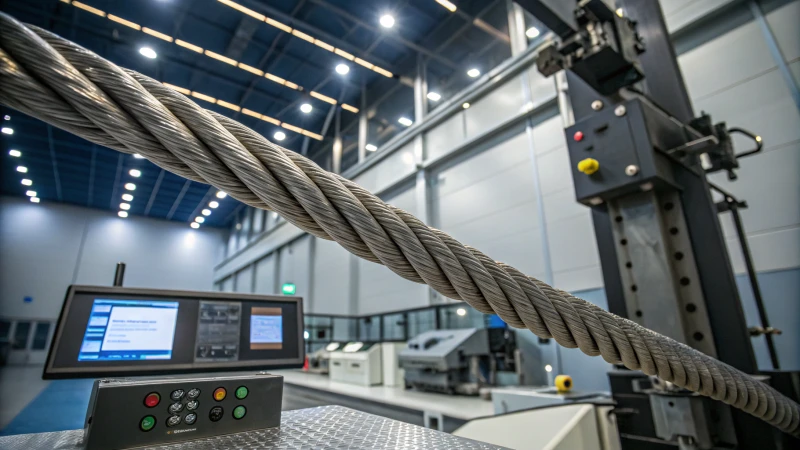
Ever wondered how those seemingly simple steel wires play such a crucial role in your car's safety?
Steel wire ropes in automotive manufacturing undergo rigorous testing and certification to ensure they meet high industry standards for safety and performance. Certifications like ISO 9001 and CE marking confirm their strength and durability, while fatigue testing ensures they can handle various conditions.
I remember when I first learned about the role of steel wire ropes in car manufacturing. It was during a factory visit, watching these ropes in action, that it hit me how crucial they are for safety. While testing and certification might sound straightforward, the processes involved are anything but simple.
Each test, from fatigue to strength, plays a vital role in confirming that these ropes can withstand the demands of automotive applications. Industry standards like ISO 9001 and CE marking are not just stamps of approval; they're assurances of quality and reliability that give manufacturers peace of mind. As technology evolves, manufacturers are increasingly adopting advanced testing methods to ensure that every rope is up to the task, providing optimal performance under the toughest conditions.
ISO 9001 is a certification for steel wire rope strength.False
ISO 9001 is a quality management standard, not specific to strength.
Fatigue testing ensures steel ropes perform under varied conditions.True
Fatigue testing assesses durability and performance in different scenarios.
What are the key tests for steel wire ropes in automotive applications?
Imagine dangling on a steel wire rope that's your lifeline—quite literally! In automotive applications, these ropes undergo rigorous tests to ensure safety and reliability.
Key tests for steel wire ropes in automotive applications include tensile strength, fatigue resistance, corrosion resistance, and flexibility assessments. These tests ensure that the ropes meet safety standards and perform reliably under stress.

Tensile Strength Testing
I remember the first time I witnessed a tensile strength test. Watching the steel wire rope stretch until it reached its breaking point was like watching a suspenseful movie scene. This test is crucial because, in automotive settings, you often face high tension. Engineers push the rope to its limits by applying increasing force until it fails, and this helps us understand its maximum load capacity. It's like knowing how much weight a bridge can hold before you decide to drive across it.
Fatigue Resistance Testing
Have you ever thought about how many times your car’s suspension system absorbs shocks while driving over bumps? Fatigue resistance testing is similar but for steel wire ropes. These ropes need to endure repetitive loads without failing—like a marathon runner who never tires out. This test simulates those cyclic stresses, revealing how long the rope can last before showing any signs of wear or failure. It’s comforting to know that such a test prevents unexpected breakdowns, enhancing safety for everyone.
Explore Fatigue Testing Methods2
Corrosion Resistance Assessment
Picture your car battling rain, snow, and road salt; the struggle is real! Corrosion resistance testing for steel wire ropes is just as critical. This assessment determines how well the rope can withstand corrosive environments over time, ensuring they last longer and remain reliable. It's like giving the rope a suit of armor against the harsh elements.
Flexibility and Bend Testing
I once bent a paperclip back and forth until it snapped—just to see how flexible it was. Flexibility tests for steel wire ropes work on the same principle but are far more sophisticated. These tests ensure that ropes can bend and flex in automotive machinery without losing their integrity. During a bend test, ropes are repeatedly bent over pulleys or other objects to see how durable they are under pressure.
Learn About Flexibility Testing3
| Test Type | Purpose |
|---|---|
| Tensile Strength | Measures maximum load capacity |
| Fatigue Resistance | Assesses durability under repetitive stress |
| Corrosion Resistance | Evaluates durability in corrosive environments |
| Flexibility and Bend | Determines ability to maintain integrity while bending |
Advanced Testing Technologies
Nowadays, technology lets us look inside without breaking things apart, thanks to nondestructive testing (NDT). Imagine using X-ray vision on steel wire ropes! Techniques like magnetic flux leakage and ultrasonic testing reveal internal defects that could otherwise remain hidden. This way, we can ensure the ropes are in top condition without damaging them.
Tensile strength tests measure maximum load capacity of ropes.True
Tensile tests assess the maximum load before rope failure.
Corrosion resistance tests are unnecessary for automotive ropes.False
Corrosion tests ensure ropes withstand harsh environments.
Why is ISO 9001 Certification Essential for Steel Wire Ropes?
Imagine knowing that your steel wire ropes are not just strong, but certified strong. That's the peace of mind ISO 9001 certification brings to the table.
ISO 9001 certification assures that a steel wire rope manufacturer maintains rigorous quality management systems, ensuring consistent product quality, boosting customer trust, and aligning with international standards essential for safety and reliability.

Understanding ISO 9001 Standards
I remember the first time I encountered ISO 9001 certification in action. It was like stepping into a world where everything just worked seamlessly. ISO 9001 is all about proving a company can consistently deliver products that meet both customer expectations and regulatory requirements. In the world of steel wire ropes, this means setting up robust processes to guarantee quality and safety every single time.
For manufacturers of steel wire ropes, adhering to ISO 9001 standards4 means establishing robust processes that ensure consistent product quality and safety.
The Role of ISO 9001 in Quality Assurance
One of the key pillars of ISO 9001 is its focus on continual improvement and risk management. Think of it like an ongoing game of chess, where you're always planning several moves ahead to ensure nothing catches you off guard. For instance:
| Process | Potential Risk | Mitigation |
|---|---|---|
| Wire Drawing | Variations in diameter | Regular calibration of equipment |
| Heat Treatment | Inconsistent tensile strength | Precise temperature control |
| Coating Application | Uneven coating leading to rust | Automated coating lines |
By sticking to ISO 9001 guidelines5, manufacturers can preemptively tackle these challenges, ensuring that the steel wire ropes are top-notch.
Enhancing Customer Satisfaction
From my experience, customers buying steel wire ropes are often looking for assurance that these ropes will stand the test of time and pressure. ISO 9001 certification acts like a badge of honor—it’s a guarantee of quality, giving clients the confidence they need in the durability and safety of the product.
In industries such as mining or construction, where steel wire ropes are subjected to extreme loads and environmental conditions, this certification becomes even more critical. Clients value suppliers who have undergone the rigorous audits necessary for ISO 9001 certification, as it reflects a commitment to quality and customer satisfaction.
Competitive Advantage in the Market
Securing ISO 9001 certification can set a company apart from the crowd. It's like having a golden ticket to new markets, especially in regions where such certifications are non-negotiable for contracts.
Achieving ISO 9001 certification can differentiate a company from competitors who do not meet these standards. It opens up new market opportunities, especially in regions where this certification is mandatory for government contracts or specific industry sectors.
Moreover, certified companies often enjoy improved efficiency and reduced waste due to streamlined processes aligned with ISO standards. This not only leads to cost savings but also positions the company as a leader in innovation and quality within the steel wire rope industry.
For manufacturers eyeing global expansion, having ISO 9001 certification can open doors to international markets eager for certified quality products. It's not just about meeting standards; it's about exceeding them, one meticulously crafted steel wire rope at a time.
ISO 9001 certification guarantees product quality.True
ISO 9001 ensures consistent quality through robust processes and standards.
ISO 9001 is optional for international market entry.False
ISO 9001 is often a requirement for entering international markets.
How do advanced testing technologies enhance rope performance?
Imagine ropes that don't just hold up under pressure but thrive in it, thanks to cutting-edge testing techniques.
Advanced testing technologies, like fatigue and tensile testing, bolster rope performance by pinpointing weaknesses and enhancing durability. These methods ensure ropes meet rigorous standards for strength, flexibility, and safety.

I remember when I first started working with ropes in construction projects. The sheer amount of trust we placed in these lifelines was immense. Each rope had to withstand harsh conditions and heavy loads without failing. That's where advanced testing technologies come into play—these aren’t just about meeting a checklist of standards; they're about ensuring every rope is as reliable as your best crew member.
The Role of Fatigue Testing
Fatigue testing is like putting your ropes through a boot camp. It simulates real-world stresses, identifying potential failure points long before they become an issue on the job site. This kind of insight is invaluable, helping us refine designs and materials. It's like having a crystal ball for predicting wear and tear, ensuring our ropes perform flawlessly in demanding environments like construction and mining.
Tensile Testing for Strength Verification
Tensile testing is the ultimate stress test—it's all about pushing a rope to its breaking point, quite literally. When we see how much load a rope can handle before it snaps, it gives us peace of mind that we're sending out products that can bear the burden of heavy machinery and lifting tasks. Safety is non-negotiable, and this testing guarantees that.
Non-Destructive Testing Methods
Sometimes you need to check something’s integrity without tearing it apart—enter non-destructive testing (NDT). Techniques like ultrasonic and magnetic particle inspections let us evaluate rope health without leaving a scratch. It’s like giving your ropes a routine check-up, ensuring they’re fit for critical operations in offshore drilling6 or crane work.
| Testing Method | Purpose | Applications |
|---|---|---|
| Fatigue Testing | Assess long-term durability | Construction, Mining |
| Tensile Testing | Determine breaking strength | Heavy Machinery |
| NDT Techniques | Inspect without damage | Offshore, Industrial |
Importance of Certification and Standards
When John, a procurement manager I know, chooses ropes for a construction project, certifications like ISO 9001 are his peace of mind. These certifications tell him—and us—that the ropes have been put through their paces with advanced testing. They’ve been vetted for quality and can be trusted to perform safely under pressure. This compliance isn’t just a nice-to-have; it’s crucial for ensuring efficiency and safety in high-stakes environments like mining operations7.
Fatigue testing helps detect rope failure points.True
Fatigue testing simulates stress conditions to identify weak spots.
Tensile testing is irrelevant for rope safety.False
Tensile testing determines the maximum load a rope can bear safely.
Why Are Safety Certifications Crucial for Compliance?
Ever wondered why safety certifications matter so much? Think of them as a seal of trust, ensuring everyone gets home safe and sound.
Certifications are essential because they confirm that companies adhere to safety regulations, bolstering workplace safety and fulfilling legal obligations. They provide assurance that safety protocols are in place, building stakeholder confidence.

The Importance of Safety Certifications
I remember the first time I had to oversee a safety audit. It felt like stepping into a world of checklists and regulations I barely understood. But as I dug deeper, I realized how certifications like ISO 45001 or OSHA compliance serve as a roadmap, guiding us through the maze of safety protocols. They’re not just paperwork—they’re about protecting lives, especially in industries where risks are part of the job, like construction or mining.
| Certification Type | Industry Focus | Key Benefits |
|---|---|---|
| ISO 45001 | General | Improves employee safety, reduces workplace risks |
| CE Mark | Manufacturing | Indicates product conformity with EU safety standards |
| OSHA Compliance | Various | Ensures adherence to occupational health standards |
How Certifications Enhance Safety Protocols
Getting certified was a game-changer for us. Regular audits felt daunting at first, but they turned out to be a blessing in disguise. They revealed gaps we never knew existed, allowing us to continuously improve and strengthen our safety measures. It’s reassuring to know that these certifications aren’t just about meeting standards—they’re about consistently evolving and improving.
Moreover, being able to show off our certifications has definitely given us an edge. Clients who prioritize safety see it as a testament to our commitment, making us a more attractive choice.
The Broader Impact of Safety Certifications
Beyond just keeping everyone safe, certifications have positively impacted other areas of our operations. We noticed fewer disruptions due to accidents, which meant more consistent productivity. Plus, it’s fostered a culture of safety among our team. When everyone knows the protocols are backed by recognized certifications, there’s a shared sense of responsibility.
This is especially true in fields that require specialized expertise—like the aerospace industry8—where every detail matters.
Challenges and Considerations
Of course, nothing worthwhile comes easy. Acquiring and maintaining these certifications requires resources—time, money, and manpower. But when I weigh these costs against the potential savings from avoiding accidents and the reputational boost we get, it’s clear they’re an investment worth making.
Different industries need different certifications based on their unique challenges. Take the maritime sector, for example—they might focus more on corrosion resistance9 because of their exposure to harsh environments. Understanding these nuances helps us make smarter decisions about which certifications align best with our needs.
ISO 45001 only applies to the construction industry.False
ISO 45001 is a general certification applicable across various industries.
Certifications can improve company reputation and client trust.True
Certified processes signal commitment to safety, attracting clients.
Conclusion
Steel wire ropes in automotive manufacturing undergo rigorous testing and certification, including tensile and fatigue tests, to ensure safety and reliability, meeting standards like ISO 9001 and CE marking.
-
Learn about tensile strength testing to ensure steel wire ropes can handle maximum loads in automotive applications. ↩
-
Explore fatigue testing methods that help prevent failures in steel wire ropes, enhancing safety and reliability. ↩
-
Understand how flexibility testing ensures steel wire ropes maintain integrity when bending in automotive uses. ↩
-
Explore how ISO 9001 standards are applied in manufacturing industries to maintain quality and safety. ↩
-
Discover how ISO 9001 guidelines help companies manage risks and improve quality assurance processes. ↩
-
Explore this link to understand how testing enhances rope performance in offshore drilling. ↩
-
Find out how compliance with standards ensures safety in mining operations. ↩
-
Discover the role of certifications in maintaining high safety standards in aerospace operations. ↩
-
Learn about certifications addressing corrosion resistance crucial for maritime safety. ↩

